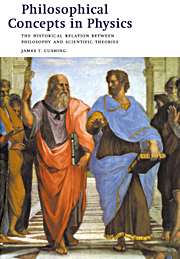 Philosophical Concepts in Physics
Philosophical Concepts in Physics Book contents
- Frontmatter
- Contents
- Preface
- Copyright acknowledgments
- PART I The scientific enterprise
- PART II Ancient and modern models of the universe
- PART III The Newtonian universe
- 7 Newton's Principia
- 8 Newton's law of universal gravitation
- 9 Some old questions revisited
- PART IV A perspective
- PART V Mechanical versus electrodynamical world views
- PART VI The theory of relativity
- PART VII The quantum world and the completeness of quantum mechanics
- PART VIII Some philosophical lessons from quantum mechanics
- PART IX A retrospective
- Notes
- General references
- Bibliography
- Author index
- Subject index
9 - Some old questions revisited
Published online by Cambridge University Press: 05 June 2012
- Frontmatter
- Contents
- Preface
- Copyright acknowledgments
- PART I The scientific enterprise
- PART II Ancient and modern models of the universe
- PART III The Newtonian universe
- 7 Newton's Principia
- 8 Newton's law of universal gravitation
- 9 Some old questions revisited
- PART IV A perspective
- PART V Mechanical versus electrodynamical world views
- PART VI The theory of relativity
- PART VII The quantum world and the completeness of quantum mechanics
- PART VIII Some philosophical lessons from quantum mechanics
- PART IX A retrospective
- Notes
- General references
- Bibliography
- Author index
- Subject index
Summary
In the previous two chapters we discussed, largely in terms of modern mathematical notation, Newton's three laws of motion and his deduction of the law of universal gravitation. Here we attempt to give the reader some appreciation of the type of mathematical arguments that Newton actually employed in the Principia. Then we show how his laws of motion and of gravitation can be used to deduce Kepler's three laws as necessary logical consequences of this overarching theory. (Some of the material here is a bit more technically involved that that in previous chapters. The reader whose tastes such details do not suit can simply move onto Chapter 10.) As we have already seen in the last chapter, Newton accepted Kepler's laws and was able to argue from them to the inverse-square nature of the gravitational attraction between any two bodies. He then reversed the line of argument and, assuming the validity of the law of gravitation, derived Kepler's three laws of planetary motion. For example, we find in the Principia:
The planets move in ellipses which have their common focus in the centre of the sun; and, by radii drawn to that centre, they describe areas proportional to the times of description.
This contains Kepler's first and second laws together. Of course, we expect to be able to do more than simply recover Kepler's laws that were, after all, used to deduce the law of gravitation itself.
- Type
- Chapter
- Information
- Philosophical Concepts in PhysicsThe Historical Relation between Philosophy and Scientific Theories, pp. 114 - 132Publisher: Cambridge University PressPrint publication year: 1998
